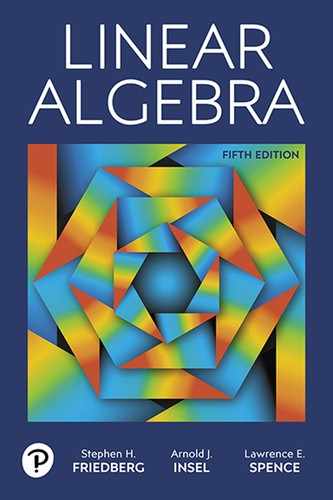To the Student
In a general sense, we can think of linear algebra as the mathematics of linear processes. It is concerned with sets of objects, called vector spaces, in which a concept of linearity exists, and with special functions defined on vector spaces, called linear transformations, that preserve linearity. Although linear algebra is a branch of pure mathematics, it plays an essential role in many areas of applied mathematics, statistics, engineering, and physics. With the recent development of computers, the importance of computations, simulations, and modeling has greatly expanded the use of linear algebra to other disciplines also. In this book, we present applications of linear algebra to the study of differential equations, statistics, genetics, and physics, among others.
This book is intended to be used as a textbook for an advanced linear algebra course, but it assumes no previous coursework in linear algebra. The emphasis in this book is on understanding the conceptual ideas that are presented here and using them to justify other results, that is, to be able to write mathematical proofs.
One of the first obstacles to overcome in order to communicate in any advanced field of study is mastering the vocabulary of that field. In mathematics, a definition is a very precise statement about the properties that must be possessed by an object being defined. These properties tell you exactly what you must verify in order to show that an object satisfies its definition. For example, on pages 6-7, the definition of a vector space is given. To prove that a certain set V with specific operations of addition and scalar multiplication is a vector space, you must verify that conditions (VS1) through (VS8) hold for V with these operations. Exercises 10-13 in Section 1.2 ask you to do exactly this. There is no way that anyone could do these exercises without understanding the meaning of conditions (VS1) through (VS8). So before doing any of the exercises in a section, be certain that you understand the meaning of all of the terms defined in that section. It is also a good idea to remember a few examples of each concept that is defined.
After you have learned the new vocabulary in a section, learn its main results, which are usually found in theorems. Pay particular attention to these, being certain that you understand thoroughly everything that is being said. Then try to express the result in your own words. If you can’t communicate an idea in writing, then you probably don’t understand it well.
Perhaps you have heard a mathematics instructor say that mathematics is not a spectator sport. This is because one of the best ways to learn mathematics is by working exercises. The exercise sets in this book begin with true/false questions that test your understanding of important ideas (and vocabulary!) in each section. Some problems that require only basic computations may follow. Then come exercises that ask for an explanation, justification, or conjecture. These different types of exercises will help you learn different aspects of linear algebra. Not only do the exercises help you to check your understanding of important concepts, but they also provide an opportunity to practice the vocabulary and symbolism that you are learning. For this reason, regular work on exercises is essential for success. We have provided a solution to one of the theoretical exercises in each section of the text. These exercises each have their exercise number printed within a gray colored box, and the last sentence of each of these exercises gives a short URL for its online solution. See, for example, Exercise 5 on page 6.
Here are some specific suggestions that will enable you to get the most from your study of linear algebra.
Carefully read each section before the classroom discussion
Some students use a textbook only as a source of examples when working exercises. This approach does not yield the full benefit from either the textbook or the classroom discussions. By reading the text before a discussion occurs, you get an overview of the material to be discussed and know what you understand and what you don’t.
Prepare regularly for each class
You cannot expect to learn to play a musical instrument merely by attending lessons once a week—long and careful practice between lessons is necessary. So it is with linear algebra. At the least, you should study the material presented in class and work assigned exercises that deal with the new material.
Each new lesson usually introduces several important concepts or definitions that must be learned in order for subsequent sections to be understood. As a result, falling behind in your study by even a single day prevents you from understanding the material that follows. To be successful, you must learn the new material as it arises and not wait to study until you are less busy or until an exam is imminent.
Review often
As you attempt to understand new material, you may become aware that you have forgotten some previous material or that you haven’t understood it well enough. By relearning such material, you not only gain a deeper understanding of previous topics, but you also enable yourself to learn new ideas more quickly and more deeply. Discussing topics with classmates can be a useful way of reviewing.
We hope that your study of linear algebra is successful and that you take from the subject concepts and techniques that are useful in future courses and in your career.
